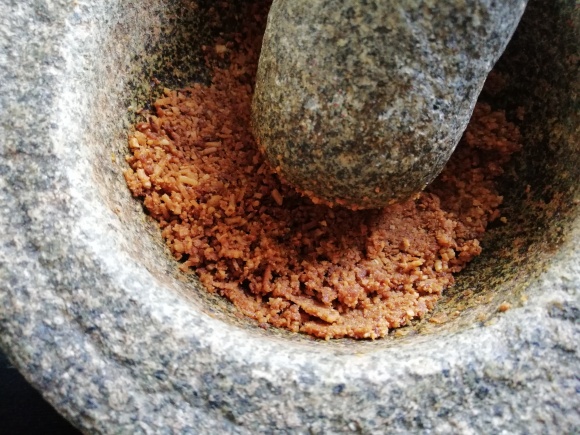Since making a return to social media, my timeline was inundated by the furore which followed the ousting of a Malaysian contestant of Masterchef UK. Apparently, Madam Zaleha’s Chicken Rendang, which accompanied the ubiquitous Malaysian Nasi Lemak, was not up to scratch.
In case you haven’t seen this, here is a snippet of the episode:
Source: Galvintan.com
This was followed by a social media backlash, primarily from Malaysians who felt Madam Zaleha was unfairly ousted for executing a rather complex dish, and not incorrectly. Skin on or skin off aside, it would be impossible for anyone to get crispy chicken skin from a chicken stew. It defies physics. It defies common sense. It repulses Malaysians because if there is one thing that Malaysians care about, it is the unique cuisine we own from having a multi cultural, multi religious society. It’s sacred and it’s sacrilegious (even for hard core atheists) to bungle up and misrepresent heritage dishes.
That being said, I have struggled sometimes with introducing heritage dishes to non Malaysian friends. This is understandable; the flavours are usually complex, multi-layered and when spicy – renders the novice food taster limp and coiled in a fetal position, refusing any further spoonfuls despite coaxing and with boxes of Kleenex.
(This is also probably why Malaysians like a very sweet ‘teh tarik’ (pulled tea), as the sweet condensed milk usually helps salve some of the spiciness from sambals and curries.)
Other than flavours, the major complaint I get about quintessential Malaysian fare from the local corner shop is the state of the curries. Generally, I’m told it looks like “a hacked up chicken in gravy” and other things like “Who puts wings in a stew?!”. I get it; not everyone was conditioned to eat chicken bone-in. Despite my impassioned pleas that chicken bones help impart depth to Malaysian stews and curries, I was told it was a health hazard and “just quite disgusting”.
Having moved out to the Bay Area, and occasionally lusting after Malaysian delights, I was like a kid in a candy store when the shops stocked red chilies. I mean, I was really chuffed. This meant I didn’t have to search fruitlessly across the internet for instant ‘sambal tumis’, a Malaysian staple with nasi lemak and a versatile condiment served on the side or used as a base to cook a variety of dishes, such as Sambal Fried Rice or spicy stir fries. Armed with a bag full of chilies, overpriced shallots, an over supply of Arbol chilies and lemongrass I would embark on creating a stock of ‘sambal tumis’ to rival the apocalypse. I also used the ‘sambal tumis’ to make Chicken Rendang – and instead of “hacking a bird” (which I’m really not adept at, even with a Chinese meat cleaver) I prepared a few beautiful breasts, daintily portioned with a paring knife.
So, in showing solidarity with Madam Zaleha, I am sharing my own Chicken Rendang Recipe here – if you dare to attempt it.
Disclaimer: This is “ferociously spicy”. Please do not attempt to prepare the chilies with your bare hands – you have been warned. This is a laborious dish to make, and you will succeed and when you do, you will most likely collapse onto your sofa and think “Damn, how did that woman do it in record time AND make an omelette?”
Here’s to you Madam Zaleha – Hidup Malaysia!
Melly’s Chicken Rendang

Aromatics (Blitz in a blender)
1 large shallot
2 cloves garlic
2 inches aged ginger – skinned, pounded (or 1 inch ginger, 1 inch galangal)
1 large lemongrass
Dry spices (toast all whole spices)
1 cinnamon stick
4 cloves
2 whole star anise
6 cardamom pods
2 tsp coriander powder or 1 tsp coriander seeds
1 tsp turmeric
1 tbsp chili powder (optional for added spiciness)
Seasonings & Other Ingredients
100ml peanut oil/grapeseed/sunflower oil for cooking
3 tbsp ‘sambal tumis’ base
100ml thick coconut milk*
100ml standard coconut milk*
50ml chicken stock
1 ½ tbsp ‘kerisik’
1 tsp tamarind paste/concentrate with 1.5 tbsp water (comes in a jar, looks like molasses)
2 tsp sea salt
1 ½ tsp brown sugar
600gm chicken meat, breast cut into 1.5 inch pieces (about 4-5 portions per breast)
200gm potatoes, skinned and cut into 1 inch thick chunks
*Tinned coconut milk is thick in nature. Spoon directly from the tin for the thick version, and then add an equal amount of water to milk to make the standard version. Therefore, you’d really need 50ml of thick coconut milk to 50ml of water.
Method
Heat a wide pan or wok. Once the pan is hot, introduce your cooking oil and wait until the oil is heated through. Stir fry aromatics until fragrant, and onions softened. Add dry spices, stir fry for 5 minutes until you detect the fragrance then add ‘sambal tumis’ base to combine.
Reduce to medium heat. Stir gently until the paste separates from the oil, and the oil begins to take colour. The aroma of spices should be significant at this point. Add potatoes and coat them with the chili paste. Gently stir for 5 mins to ensure the chili paste doesn’t stick to the pan and burn.
Add chicken and coat with chili paste. Continue to stir and cook for 10 mins; add chicken stock to combine. Add thick coconut milk to the pot and stir, reduce heat and simmer for 15 mins. Remove chicken pieces and add standard coconut milk, kerisik, tamarind paste, salt and sugar to complete the gravy. The gravy should now take on a caramelised, darker hue. Taste and adjust seasoning (salt, sugar, tamarind paste) to your desired balance of sweet, savoury and tangy. Continue to simmer the sauce for another 20 mins, stirring regularly to ensure it doesn’t burn or stick to the pan.
Re-introduce chicken to the pot, stir to combine and continue to simmer until the gravy is reduced to a thick consistency (approximately 10 mins).
Serve hot with coconut rice or turmeric rice.
UPDATED: Beef Rendang
To make a Beef Rendang, use the same amount of ingredients and weight of meat. You can use up to 2lbs (a little under 1kg) of beef with this recipe, but you will need to increase:
- Sambal Tumis – 6 tablespoons
- Chicken Stock – 200ml
There’s less liquid in beef so you’ll want to keep an eye on liquids to ensure the paste doesn’t burn at the bottom of the pan while cooking the beef and potatoes.
Sambal Tumis
100ml grapeseed/peanut/sunflower oil
20 fresh red chilies, deseeded and chopped
5 large or 12 small shallots (portion equivalent to 2/3 of the chilies), sliced
3 cloves of garlic
30 dried Arbol chilies, deseeded and soaked in hot water (portion equivalent to fresh red chilies)
2 stalks of lemongrass, bruised
3 tsp tamarind paste/concentrate with 1.5 tbsp of water (comes in a jar, looks like molasses)
2 tbsp brown sugar
1 ½ tbsp sea salt
3 fresh kaffir lime leaves
Zest & juice of 1 kaffir lime
Method
In a food processor, blend the shallots and garlic into a paste. Separately process the fresh red chilies and soaked Arbol chilies into pastes, respectively.
Heat a wide pan or wok. Once the pan is hot, introduce your cooking oil and wait until the oil is heated through. Stir fry onions and garlic until onions are soft. Add blended Arbol chilies, and gently stir for 10 mins to cook the chili. Then add the blended red chilies, kaffir lime leaves and lemongrass, and cook for another 10 mins until the chili paste starts to separate from the oil, and the oil begins to take colour. Season with sugar, salt and tamarind paste. Taste the sambal to ensure you have the right balance of sweet, salty and tangy (adjust where necessary).
Finish with kaffir lime zest and juice. Enjoy as a condiment on fried fish, chicken or egg with rice.
Note on storing: Leave to cool before storing. Sambal is good frozen up to 6 weeks, or 1 week in the chiller. Always scoop sambal with a clean spoon so as not to contaminate the remaining sambal in storage container. Not suitable to be microwaved and re-frozen. Frozen sambal should be thawed in the fridge, then gently reheated in a pan.
Kerisik
50gm unsweetened shredded coconut
Special equipment: Mortar & Pestle
Method:
In a non stick pan, gently toast shredded coconut on low heat until it is browned. You will notice the distinct aroma of coconut oil, and a slight sheen on your pan.

Once done, pour the still toasty coconut into your mortar and begin alternating between light pounding and grinding (moving your pestle in a circular motion around the base of the mortar) to break down the toasted coconut. It should slowly begin to resemble a caramelised, coconut butter. Continue to grind until your shredded coconut has been reduced to a runny paste, transfer to a bowl/container and leave in the fridge until you are ready to use it. Kerisik can last up to 3 days in the fridge and will solidify.


























































































